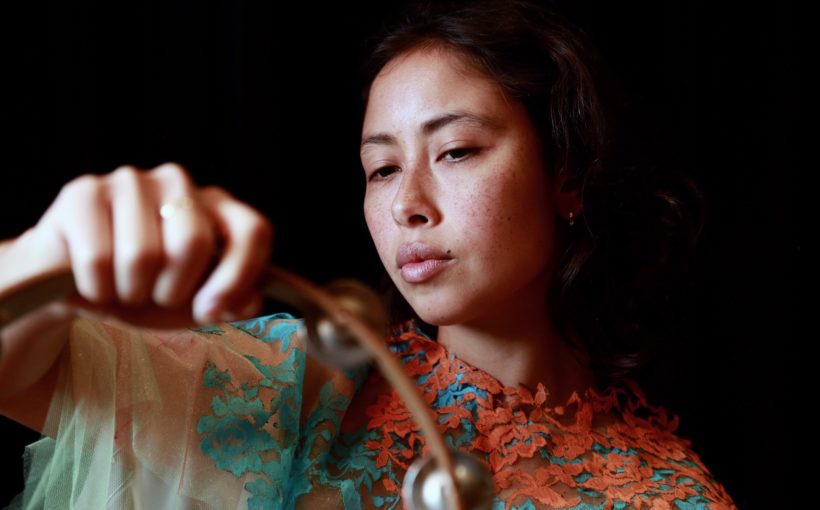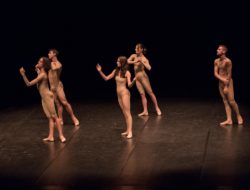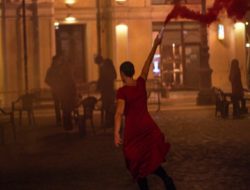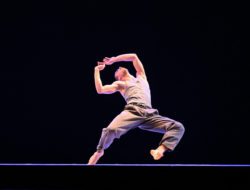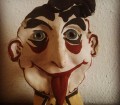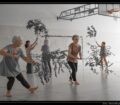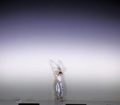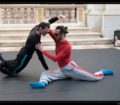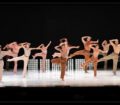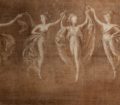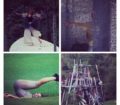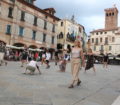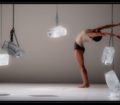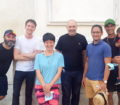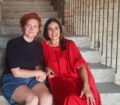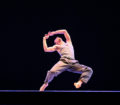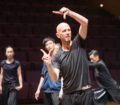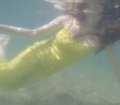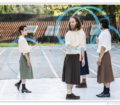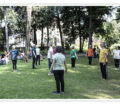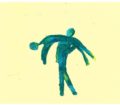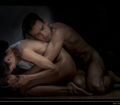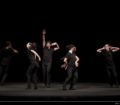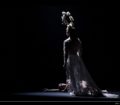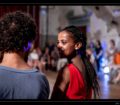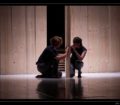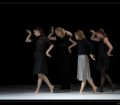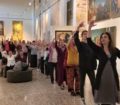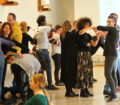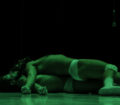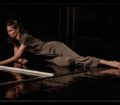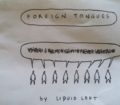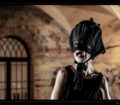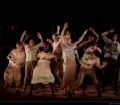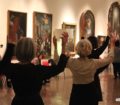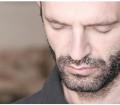La versione originale in italiano segue il testo inglese, dopo il video.
ENG| Lilian Steiner is a freelance dancer and choreographer from Melbourne, who works also with visual arts and experimental sound performance. In the last ten years she has collaborated as a professional dancer with various choreographers and dance companies, such as Lucy Guering Inc. Phillip Adams (Balletlab), Shelley Lasica, Melanie Lane, Brooke Stamp, Leah Landau and Rennie McDougall, and in the meantime, for about 5 years, she has led her own choreographic research, which enabled her to receive the Green Room Award as best dancer both in 2017 and in 2018, as well as the Helpmann Award in 2017.
“I’m Australian, my mother is Chinese-Malay, that’s why I have this look, my dad is Hungarian-Czech, but I am from Australia!”- she reaffirms, smiling.
Long, dark hair and deep black eyes, soft voice, slender figure: everything about Lilian Steiner gives off an elegant and delicate beauty, almost fragile. But, when on stage, all her strength and determination comes out, as well as the ability to transform her own body into a visual, auditory, and conceptual experience.
We had the pleasure of meeting and having a quick chat with Lilian Steiner during BMotion Dance 2019, where she held the premiere of her most recent work “Siren Dance”.
The siren is a creature that, for millennia, has been able to make us undertake extremely long journeys. The alluring body, the tantalizing voice, master of metamorphosis and melancholy. Some call her a nymph, some a monster, others a demon. We have spotted her in Homer’s verses and in those of Rilke, we have listened to her voice in the words of Joyce and in the music of Wagner. In Lilian Steiner’s piece, the siren becomes – with her dance- the symbol of modern treachery, of reality and truth that are constantly manipulated by ourselves and by others. Indeed, all of us, in our own small, big story, can play the part of both the alluring siren and the lost sailor.
Could you tell us how your career as a dancer started?
I studied dance at the Victorian College of the Arts in Melbourne, Australia. Why I chose dance? I was a very cheeky girl and so my parents signed me up at the ballet school to get some discipline. It’s funny because now dance has become my career. When I found myself having to choose which faculty I wanted to enrol in at university I felt very undecided, because there was nothing I found really stimulating. Although I was interested in science – my father is an aerospace engineer and academic – and humanitarian subjects, nothing was more stimulating in an ongoing way than dance. During high school I used to go dancing 6 days a week because it made me truly happy. It was the one way I could enjoy my time at school, knowing that I would then go dancing once classes ended. So I decided to follow what made me happy. There was never a moment when I asked myself whether I was doing the right thing, I never had a doubt.
What is dance for you?
For me, dance makes a lot of sense. Dance allows me to think and express myself in a way that I truly feel as my own. It is a form of expression in which you cannot be anything other than yourself, you can’t lie. You can’t be someone you’re not, otherwise you fail.
Where did the inspiration for “Siren Dance” come from?
I think it derives from something that recently happened in my life. In particular from the ability of people or of things to suddenly change form. Intentions transform rapidly and what may initially start out as truth can easily become fiction. At times, the people we interact with, or the situations we are experiencing, may seem beautiful, shiny, thrilling to our eyes, but then they suddenly (“it’s a turning point”) transform into something that is the complete opposite, becoming chaos or something dangerous, or extremely destructive. This has led me to the mythological sense of sirens and of everything that can be enticing, magnetic, illusionistic- that is able to engulf us slowly to then spit us out like a monster.
In Siren Dance, classic and contemporary meet and clash, giving rise to that “turning point” you just talked to us about, could you tell us a bit more about the medium you used and in which way your diverse culture and background can influence- or not- your work?
My cultural background can emerge at times throughout the expressive journey, at an aesthetic and instinctive level. But actually in this work I don’t think a lot about culture, but rather about symbolism. I hadn’t worn pointe shoes for 9 years, this is the first time. And I felt both very scared and very excited at the same time. For me, pointe shoes are the symbol of beauty, a classic beauty, an illusory one. Because they allow you to elevate yourself in space and to magically float above the ground- certainly not a human quality. They convey an idea of illusion that is very important to me. During the performance I also use the tambourine, which symbolises instead something sweet, upbeat, carefree, it is a sort of classic cliché, similar to a fairytale in a way, while the chain that I use straight after is the complete opposite. It is a heavy, cold, aggressive object even if it isn’t used to attack, but for the sounds and noises it produces. And so this leads me back to the fact that we are drawn to and attracted by something that we already know isn’t good for us, but which we are unable to resist.
During this edition of BMotion Dance we have talked a lot about dialogue. What is dialogue for you?
For me, dance has the ability to create a unique dialogue with the audience, whether it is an audience of one or of five-hundred. Because it creates a very intimate moment where one body looks at another body, a person looks at another person up-close. Regardless of whether eye-contact is established or not, or whether some information is passed, an exchange of energy nonetheless takes place, a moment of sharing. And it is a dialogue that will continue in space and time, through one’s own experiences, through new exchanges, or the memory of images and sensations that resurface in time. On the performance side, in my opinion there is always something vulnerable, not in terms of fragility or weakness, but in terms of strenght: the vulnerability/strenght of someone who is showing and offering something of himself. There is this moment where something is offered and something is being watched and in between there is the dialogue.
Rita Borga
English translation by Elena Baggio
ITA| Lilian Steiner è una danzatrice e coreografa freelance di Melbourne, che lavora anche con le arti visive e la sperimentazione di performance sonore. Negli ultimi dieci anni ha collaborato come danzatrice professionista con diversi coreografi e compagnie come Lucy Guering Inc. Phillip Adams (Balletlab), Shelley Lasica, Melanie Lane, Brooke Stamp, Leah Landau and Rennie McDougall, e da circa 5 anni, ha iniziato anche a condurre una propria esplorazione coreografica che l’ha portata a ricevere il Green Room Award come miglior ballerina sia nel 2017 che nel 2018, nonché l’Helpmann Award nel 2017.
«Sono australiana, mia madre è cinese malese ed è per questo che il mio viso ha questo aspetto; mio padre è ungherese cecoslovacco, ma io vengo dall’Australia!» – ribadisce sorridendo.
Capelli lunghi e scuri su profondi occhi neri, la voce dolce, il corpo sottile: tutto in Lilian Steiner esprime una bellezza elegante e delicata, quasi fragile. Sul palco però viene fuori anche tutta la sua forza e determinatezza, e la capacità di trasformare il proprio corpo in un’esperienza visiva, sonora, concettuale.
Abbiamo avuto il piacere di incontrare e fare una piccola chiacchierata con Lilian Steiner durante BMotion Danza 2019 dove ha presentato in prima nazionale il suo ultimo lavoro “Siren Dance”.
La sirena è una creatura che da millenni è in grado di farci compiere lunghissimi viaggi. Il corpo ammaliante, la voce tentatrice, maestra di metamorfosi e malinconia. C’è chi la chiama ninfa, chi mostro, qualcuno addirittura demone. L’abbiamo avvistata nei versi di Omero e in quelli di Rilke, ne abbiamo ascoltato il canto nelle pagine di Joyce e nella musica di Wagner. Nella piece di Lilian Steiner la sirena diventa – con la sua danza – il simbolo dell’inganno moderno, della realtà e della verità costantemente manipolate da noi stessi e dagli altri. Ognuno di noi, infatti, nella propria piccola e grande storia, può essere allo stesso tempo la sirena tentatrice e il marinaio perduto.
Potresti raccontarci come è iniziata la tua carriera di danzatrice?
Ho studiato danza al Victorian College of the Arts di Melbourne, in Australia. Perché ho scelto la danza? Ero una ragazzina molto vivace e disobbediente e così i miei genitori mi hanno iscritto alla scuola di ballo per mettermi un po’ in riga. È divertente perché adesso la danza è diventata la mia carriera. Quando mi trovai sul punto di dover scegliere a quale facoltà universitaria iscrivermi mi sentii molto indecisa, perché non c’era nulla di veramente stimolante per me. Pensai di scegliere qualche disciplina scientifica – mio padre è uno scienziato – o ingegneria o qualcos’altro del genere. E poi invece scelsi la danza. Durante il liceo andavo a ballare 6 giorni alla settimana perché mi rendeva davvero felice. Era il solo modo per farmi apprezzare la scuola sapere che poi a fine lezione sarei andata a ballare. Così ho scelto di seguire ciò che mi rendeva felice. Non c’è mai stato un momento in cui mi sono chiesta se stavo facendo la cosa giusta, non ho mai avuto dubbi.
Che cos’è la danza per te?
For me, Dance makes a lot of sense. La danza mi permette di pensare ed esprimermi in un modo che sento veramente mio. È una forma di espressione in cui non puoi essere altro che te stesso, non puoi mentire. Non puoi essere qualcuno che non sei, altrimenti fallisci.
Da dove è nata l’ispirazione per “Siren Dance”?
Penso che arrivi da qualcosa che è successo recentemente nella mia vita. In particolare dall’abilità delle persone o delle cose di cambiare improvvisamente forma. Le intenzioni si trasformano rapidamente e ciò che potrebbe iniziare come verità può facilmente diventare finzione. A volte le persone con cui entriamo in relazione, o le situazioni che stiamo vivendo, possono sembrare ai nostri occhi bellissime, luminose, entusiasmanti ma poi all’improvvisano (“it’s a turning point”) si trasformano in qualcosa di completamente opposto, diventando caos o qualcosa di pericoloso, o di estremamente distruttivo. Questo mi ha portato al senso mitologico delle sirene e a tutto ciò che può essere allettante, magnetico, illusionistico e che riesce a fagocitarci lentamente per poi sputarci fuori come un mostro.
In Siren Dance, classico e contemporaneo si incontrano e scontrano danno vita a quel “turning point” di cui ci hai appena detto; puoi dirci qualcosa di più sui medium che hai utilizzato e in che modo la tua cultura mista e il tuo background possono influenzare o meno il tuo lavoro?
Il mio background culturale può emergere a momenti lungo il percorso espressivo, a livello estetico e istintuale. Ma in realtà in questo lavoro non penso molto alla cultura ma più al simbolismo. Non indossavo le punte da 9 anni, questa è la prima volta. E mi sentivo allo stesso tempo molto spaventata ed eccitata. Per me le punte sono il simbolo della bellezza, una bellezza classica, e di illusione. Perché ti permettono di elevarti nello spazio, e di farti galleggiare in modo magico sopra il terreno, una qualità di certo non umana. Esprimono un’idea di illusione per me molto importante. Durante la performance utilizzo anche il tamburello che invece simboleggia qualcosa di dolce, allegro, spensierato, è una specie di cliché classico, in qualche modo simile a una fiaba, mentre la catena che utilizzo subito dopo è qualcosa di completamente opposto. È un oggetto pesante, freddo, aggressivo anche se in scena non viene utilizzato per aggredire ma per i suoni e i rumori che produce. E che quindi mi riporta di nuovo al fatto che veniamo attirati e attratti da qualcosa che già sappiamo non è un bene per noi, ma a cui non riusciamo a resistere.
Durante questa edizione di BMotion Danza si è parlato molto di dialogo. Che cos’è dialogo per te?
Per me la danza ha l’abilità di creare dialogo speciale con lo spettatore, che sia uno o cinquecento. Perché crea un momento molto intimo in cui un corpo guarda un altro corpo, una persona guarda un’altra persona in modo ravvicinato. Che si stabilisca o meno un contatto visivo, o un passaggio di informazioni, comunque avviene uno scambio di energie, una condivisione. E sarà un dialogo che poi continuerà nello spazio e nel tempo, attraverso le proprie esperienze, attraverso nuove condivisioni, o la memoria di immagini e sensazioni che riaffiorano nel tempo. Dal punto di vista della performance, secondo me c’è sempre qualcosa di vulnerabile, non nel senso di fragilità o di debolezza, ma di forza : la vulnerabilità/forza di qualcuno che sta mostrando e offrendo qualcosa di sè. Il dialogo sta nel mezzo di ciò che viene offerto e ciò che viene ricevuto.
Rita Borga
Operaestate Festival | BMotion Danza, 2019 |22 agosto 2019 Chiesetta Dell'Annunziata , Bassano del Grappa (VI) Prima nazionale LILIAN STEINER |SIREN DANCE coreografia e interpretazione Lilian Steiner musica Marco Cher-Gibard costumi Geoffrey Watson
Tags: intervista, Lilian Steiner



